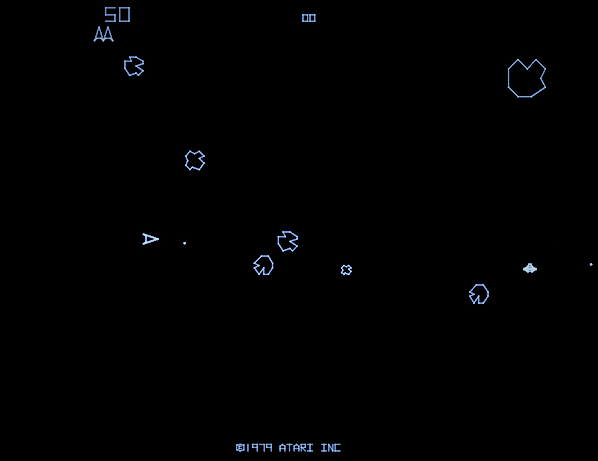Physics Essay
As of the 10th of January, I’ve conducted further research for my physics essay. One of the game’s I’ve chosen to research is known as Asteroids, I’ve specifically chosen this game because of its age and being one of the earliest known games to implement physics into its gameplay.
Developed in 1979 for the arcades made on a digital vector generator (Known as DVG), which was known to save a lot of memory as well as providing a higher resolution than raster graphics – although at the cost of colour.
“These lines were super-crisp compared to the blocky lines drawn on low-resolution raster displays. The vector display doesn’t need much memory — just a list of lines.”
computerarcheology.com, 2022
Although it was only capable of displaying a few lines using the monitor’s beam, the image was very crisp and clear As shown by Figure 1, the image of the game looks sharp and clear.

Asteroids was a challenging shooter known for its complex physics, as the game is set in space the physics relies on mostly the acceleration and deceleration of the player’s ship that they control.
The game simulates how the player’s mass moves around zero-gravity, as the player accelerates forward by force, the ship will keep moving until an external force collides and pushes it into the opposite direction – this is essentially a concept of inertia.
“Every object continues in its state of rest or motion in a straight line unless acted upon by an external force.”
Chris Deziel, 2018
A common approach to doing this would be to keep track of the player’s angle, position, velocity and force components (X and Y directions). You would then at each step calculate the acceleration components and increment the velocities first and then the position of the player afterwards.
As Figure 2 shows, these are the formulaic approach that could be used towards determining the new velocity and angle of the ship as the player goes forward towards a new angle to simulate internal momentum physics.

The post as shown goes into detail about how a force can be applied towards an angle along the components of X and Y, acceleration is also being applied to the mass of the object alongside its forces. The acceleration is then applied to the inertia and torque.
Although there is no exact clear documentation on the original game’s code, there have been many replications of it online via fangames or recreations. It would be likely that this is the exact same or similar theory of physics the developers of the based their game off of, within my essay I’ll be documenting at least methods that’ll relate to how the game works.
Bibliography
Physics Stack Exchange. 2021. Internal Momentum Physics Question in recreating an Asteroids Video Game Experience. [online] Available at: https://physics.stackexchange.com/questions/618052/internal-momentum-physics-question-in-recreating-an-asteroids-video-game-experie [Accessed 16 January 2022].
Retrogamedeconstructionzone.com. 2019. Asteroids: By the Numbers. [online] Available at: https://www.retrogamedeconstructionzone.com/2019/10/asteroids-by-numbers.html [Accessed 16 January 2022].
Computerarcheology.com. 2022. DVG. [online] Available at: https://www.computerarcheology.com/Arcade/Asteroids/DVG.html [Accessed 16 January 2022].
Rochon, M., 2017. What is Inertia?. [online] Sciencing. Available at: https://sciencing.com/what-is-inertia-13712449.html [Accessed 16 January 2022].